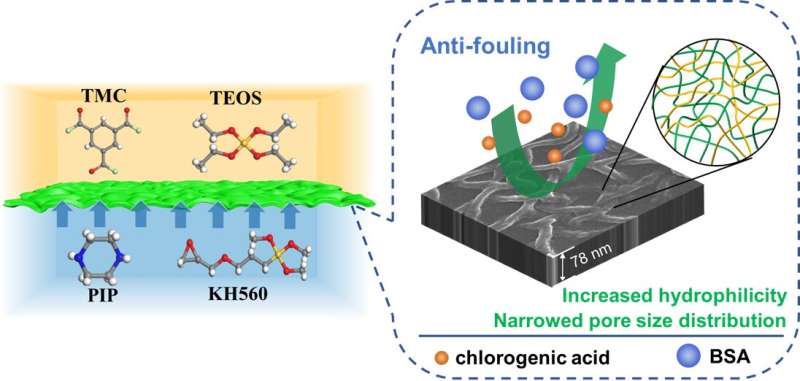Researchers regulate pore size distribution to improve nanofiltration membrane

A research group led by Prof. Wan Yinhua from the Institute of Process Engineering (IPE) of the Chinese Academy of Sciences has developed a novel antifouling nanofiltration membrane for various types of industrial liquid separation. The new membrane applies new knowledge about the role of pore size distribution in filtration.
The study was published in ACS Applied Materials & Interfaces on July 26.
Nanofiltration membranes have received a lot of attention in the field of water purification and bio-product manufacturing due to their ability to accurately separate targeted solutes from other components.
However, the application of nanofiltration membranes in industry suffers from membrane fouling that causes a significant decline in separation performance.
For example, for the most prevalent polyamide thin-film composite membrane prepared by interfacial polymerization (IP), the intrinsic heterogeneous mass transfer of the IP process results in wide pore size distribution and causes uneven permeation flux distribution on the membrane during filtration, thus weakening the antifouling ability of the nanofiltration membrane.
Moreover, commonly used nanofiltration membranes have abundant hydrophobic sites (i.e., benzene rings) in their polyamide chains. These sites are prone to adsorb hydrophobic foulants.
The researchers attempted to enhance the antifouling performance of a polyamide nanofiltration membrane by narrowing its pore size distribution via a one-step multiple IP process.
In this strategy, an aqueous solution of piperazine anhydrous (PIP) and γ-(2,3-epoxypropoxy) propytrimethoxysilane (KH560) undergoes IP with an organic solution of trimesoyl chloride and tetraethyl orthosilicate (TEOS) on the porous support.
The reactive additive KH560 accelerates the diffusion rate of PIP so it becomes enriched at the reaction boundary. Moreover, the hydrolysis/condensation of KH560 and TEOS at the aqueous/organic interface forms an interpenetrating network with the polyamide network, thus regulating the separation layer structure.
The characterization results indicate that the polyamide-silica membrane has a denser, thicker and more uniform separation layer. The mean pore sizes of the polyamide-silica membrane and a traditional polyamide membrane are 0.62 nm and 0.74 nm, respectively, and these correspond to geometric standard deviations (namely, pore size distribution) of 1.39 and 1.97, respectively. Thus, the polyamide-silica membrane with a narrower pore size distribution shows stronger antifouling performance. In this case, the flux decay ratio decreases from 18.4% to 3.8%.
Moreover, this polyamide-silica membrane exhibits impressive long-term antifouling stability during cane molasses decolorization at high temperature (50 ℃).
"This work not only provides a novel one-step multiple IP strategy to prepare antifouling nanofiltration membranes, but also emphasizes the importance of pore size distribution in fouling control for various industrial liquid separations," said Prof. Luo Jianquan of IPE, corresponding author of the study. "Such a nanofiltration membrane promises to improve the robustness of thin-film composite nanofiltration membranes in industrial liquid separation."
More information: Lulu Liu et al, Enhancing the Antifouling Ability of a Polyamide Nanofiltration Membrane by Narrowing the Pore Size Distribution via One-Step Multiple Interfacial Polymerization, ACS Applied Materials & Interfaces (2022). DOI: 10.1021/acsami.2c09408
Provided by Chinese Academy of Sciences




















